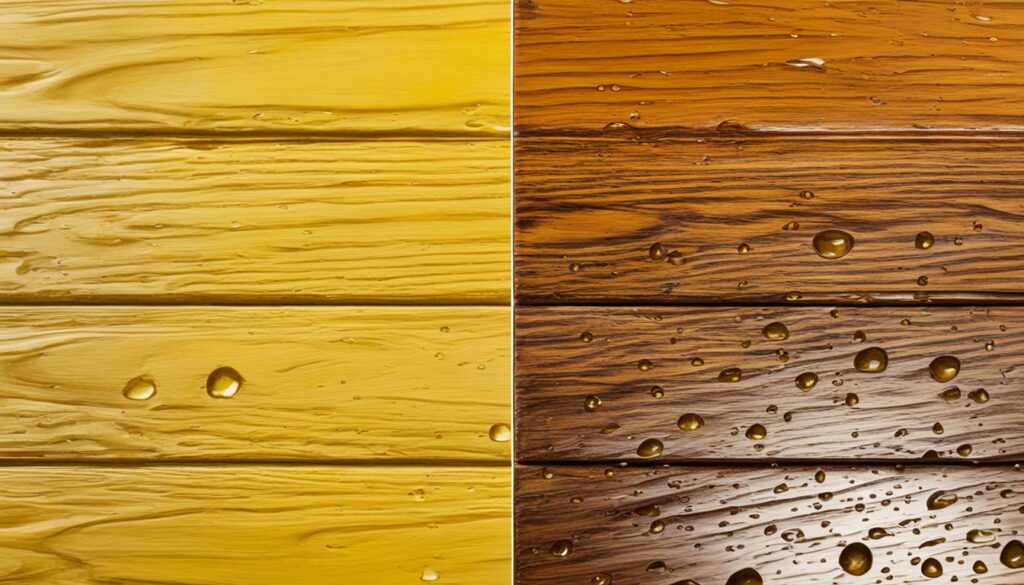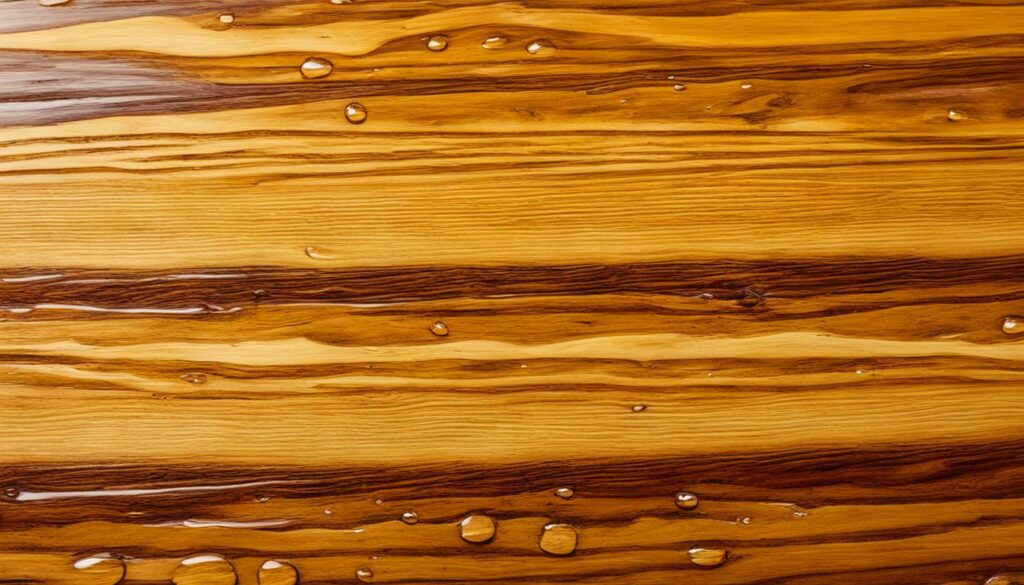Yes, you can use tung oil on a cutting board. It offers a durable, flexible finish that enhances the wood’s natural texture while providing food-grade sealing and moisture resistance. However, it has downsides, such as a prolonged drying time, an unpleasant odor during curing, and a labor-intensive application process. Additionally, tung oil is relatively expensive and lacks heat resistance. To fully understand the trade-offs and explore alternative options for cutting board maintenance, such as mineral oil or beeswax blends, further details are available.
What is Tung Oil?
Understanding tung oil begins with recognizing it as a natural, plant-based drying oil extracted from the seeds of the tung tree, native to southern China. Tung oil properties include its ability to polymerize upon exposure to air, forming a durable and water-resistant coating. This makes it a favored natural wood sealant for various applications, particularly in wood cutting board care.
Historically, tung oil has been employed since the Song Dynasty for waterproofing ships, showcasing its efficacy and longevity. As a wood finishing oil, tung oil offers numerous benefits. It penetrates deeply into the wood, enhancing the natural grain and providing a rich, satin finish. This not only improves the aesthetic appeal of wood but also offers a robust layer of protection against moisture and wear.
One of the primary tung oil benefits is its non-toxic nature once fully cured, making it a safe option for surfaces that come into contact with food. For wood cutting board care, tung oil’s ability to create a water-resistant barrier is particularly valuable, ensuring longevity and durability. Additionally, its natural composition means it does not introduce harmful chemicals into the kitchen environment, aligning with health-conscious and eco-friendly practices.
Types of Tung Oil
When choosing a tung oil finish for your cutting board, it is essential to understand the distinctions among pure tung oil, oil/varnish blends, and wiping varnishes. These variations greatly impact the final outcome and maintenance of your cutting board.
Pure tung oil, derived directly from tung tree nuts, is a nontoxic wood oil that, once fully cured, provides a durable, food-safe wood finish. Its deep penetration into the wood enhances the grain and offers a water-resistant surface ideal for wooden cutting board care. However, pure tung oil requires a lengthy curing time of around 30 days and multiple thin coats to achieve the desired finish.
Oil/varnish blends, such as Cabot’s Tung Oil Finish, combine tung oil with resins and drying agents, offering a quicker drying time and a glossier finish. These blends typically need fewer coats and are easier to apply, making them a popular choice among those seeking efficient cutting board finishes.
Wiping varnishes, like Minwax Tung Oil Finish, contain minimal tung oil and are mainly synthetic varnishes. Known for their rapid drying times and highly durable finishes, wiping varnishes are less about tung oil food safety and more about achieving a resilient, easy-to-maintain surface.
Understanding these types aids in selecting the most suitable food-safe wood finish for your cutting board.
Can I Use Tung Oil on a Cutting Board?
Using tung oil on a cutting board is a viable option when considering both its advantages and disadvantages. Tung oil is a food-safe finish once fully cured, making it suitable for surfaces that come into contact with food. As an all-natural, plant-based oil, it contains no toxic additives, which aligns with the requirements for food-grade wood oils. This oil provides a water-resistant and durable finish, effectively contributing to cutting board maintenance by protecting the wood from moisture and wear.
However, tung oil cutting board care can be more demanding compared to other wood finishes for cutting boards, such as mineral oil. One significant drawback is the extended curing time of approximately 30 days, during which the board cannot be used for food preparation due to the risk of chemicals leeching into food. Additionally, the curing process can result in an unpleasant odor.
Reapplication of tung oil also requires more effort, as sanding between coats is necessary. This makes tung oil less convenient than easily reapplicable alternatives like mineral oil. Additionally, 100% pure tung oil is typically more expensive than other food-safe finishes, which may be a consideration for some users.
For effective tung oil cutting board care, it is essential to purchase pure tung oil and adhere to the recommended curing period.
Advantages of Using Tung Oil
Applying tung oil to wood surfaces offers several notable advantages, particularly for cutting boards and other kitchen-related items. As a food-safe wood treatment, tung oil provides a durable and flexible finish that allows the wood to expand and contract without cracking. Its deep penetration into the wood grain enhances the natural texture and provides a beautiful satin sheen, making it an excellent wood conditioner for cutting boards.
One of tung oil’s primary benefits is its ability to serve as a food-grade wood sealant. Once fully cured, which takes approximately 30 days, it is safe for direct contact with food, making it ideal for kitchen wood maintenance. Additionally, tung oil does not yellow over time or become rancid, ensuring that the cutting board maintains its aesthetic appeal and functionality.
Tung oil also offers the following advantages:
- Water and Moisture Resistance: It provides a waterproof and moisture-resistant finish, essential for cutting board seasoning.
- Eco-Friendly: As an all-natural, plant-based product, tung oil contains no volatile organic compounds (VOCs), making it an environmentally responsible choice.
- Easy Maintenance: The finish is easy to maintain and repair, requiring only periodic reapplication without the need for extensive sanding.
Disadvantages of Tung Oil
Despite its numerous benefits, tung oil also presents several significant disadvantages that must be considered. One of the primary drawbacks is the long tung oil drying time. It can take up to 30 days for the oil to fully cure, which delays the usability of the cutting board for food preparation. This extended curing period poses a risk to tung oil safety, as chemicals could potentially leach into food if the board is used prematurely.
Another concern is the unpleasant odor that tung oil emits during the curing process. This can be particularly bothersome and may require good ventilation or even the use of a mask during application.
Moreover, 100% pure tung oil is relatively expensive, costing approximately 25% more than other finishes such as mineral oil, which is commonly used for cutting board conditioning. The application process is also labor-intensive, requiring meticulous sanding between each of the multiple coats to achieve a smooth finish.
In terms of wooden cutting board maintenance, tung oil does not smooth the wood grain, often leaving the surface rougher than desirable. Additionally, it is not heat-resistant, which can lead to deterioration if the board is exposed to high temperatures.
These factors collectively highlight the importance of weighing tung oil pros and cons before deciding on its use.
Applying Tung Oil Finish to Cutting Boards
Proper preparation and meticulous application are essential for achieving a durable and food-safe tung oil finish on cutting boards. To start, thoroughly sand the cutting board up to 220 grit sandpaper to ensure a smooth surface for the tung oil to adhere to. Remove any dust with a damp cloth and allow the board to dry completely before proceeding with the cutting board oiling process.
For the first coat, thin 100% pure tung oil with an equal amount of citrus solvent or mineral spirits to enhance penetration into the wooden surface. Apply a thin, even coat using a clean, lint-free rag or brush. Wipe off any excess oil that does not absorb after 20-30 minutes and allow the first coat to cure for 24-48 hours.
Subsequent coats should use pure tung oil without thinners:
- Apply very thin coats and wipe off excess.
- Allow at least 24 hours of drying time between coats.
- Sand lightly with 320-400 grit between coats for a smoother finish.
A minimum of 3-5 thin coats is recommended. Once the final coat is applied, allow the tung oil to cure for 30 days before using the board for food preparation.
Regular maintenance, including reapplying oil when the board appears dry, is essential for butcher block maintenance and ensuring a food-safe wood finish.
Alternatives to Tung Oil for Cutting Boards
When considering finishes for cutting boards, mineral oil frequently emerges as a popular and practical alternative to tung oil. Food-grade mineral oil is non-toxic, odorless, and prevents wood from drying out and cracking. It’s easy to reapply without sanding or extensive curing times, making it a convenient choice for maintaining cutting boards.
Another alternative is walnut oil, derived from English walnuts. It imparts a warm color to the wood but may pose allergen concerns and can go rancid over time. Beeswax, often combined with mineral oil, adds water resistance and a protective coating. Pre-mixed options or DIY blends are available, and plant-based vegan waxes serve as alternatives.
Shellac, used by some woodworkers, offers a food-safe, harder coating than oils alone. It can be applied in thin coats to avoid a glossy finish but may need more frequent reapplication compared to tung oil.
Below is a comparison of these alternatives:
| Finish Type | Pros | Cons |
|---|---|---|
| Food Grade Mineral Oil | Non-toxic, easy to reapply, inexpensive | Less water-resistant than tung oil |
| Walnut Oil | Warm color, natural | Allergen risk, can go rancid |
| Beeswax | Adds water resistance, protective coating | Requires blending with oil, can be costly |
Each option offers unique benefits and drawbacks, allowing users to choose based on specific needs and preferences.
Welcome to WoodCraftYard.com, your one-stop destination for all things woodworking! I’m Oliver Candler, a dedicated woodworking aficionado and the creative mind behind this virtual woodworking haven. With a deep-rooted love for craftsmanship and a keen eye for detail, I am on a mission to share my passion for woodworking with fellow enthusiasts like yourself.
As a seasoned woodworker, I am committed to providing you with valuable insights, practical tips, and inspiring project ideas to help you unleash your creativity and master the art of woodworking. Whether you’re a seasoned pro or just starting out on your woodworking journey, join me as we carve, sand, and saw our way through the world of woodworking together.
Let’s embark on this woodworking adventure, where every knot, grain, and finish tells a unique story. Together, let’s craft, create, and build something truly extraordinary at WoodCraftYard.com!




